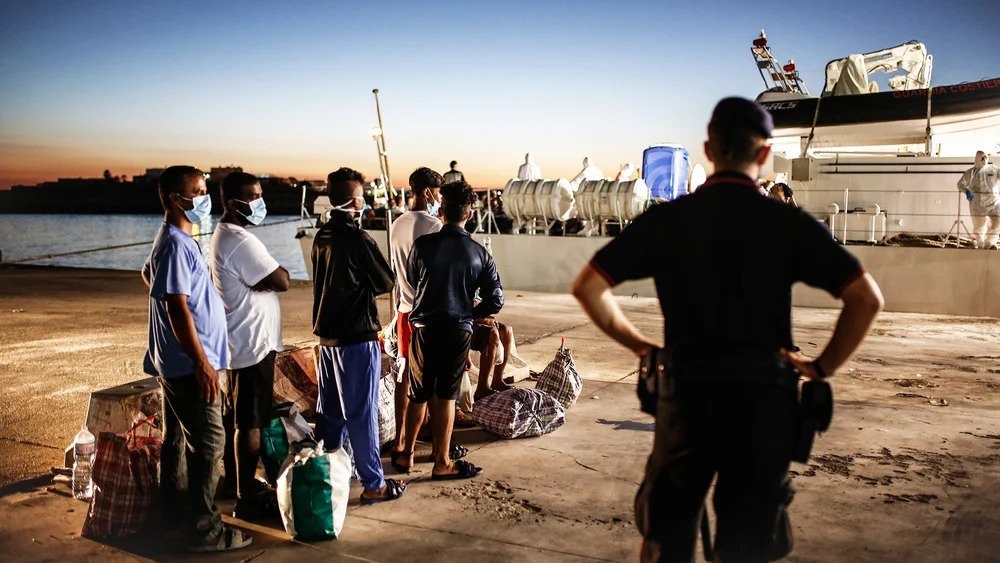
The number of asylum seekers and migrants crossing the Mediterranean to reach Italy has surged this year, according to EU officials. More than 56,000 people have made the journey–almost double the total over the same period last year. The increase prompted Italy’s government to declare a six-month state of emergency in April, in part to address overcrowding at a center for those who arrive on the Italian island of Lampedusa.
But experienced aid workers say the focus on numbers is distracting from the real issues: dire conditions in North Africa—most recently Tunisia—pushing more people to take dangerous journeys at sea; and an Italian migration reception system near collapse due to years of politicization and neglect.
“The emergency at the moment is the way these people arrive and how they are welcomed, rather than the numbers,” Emma Conti, an aid worker based in Lampedusa since 2014, told The New Humanitarian.
The route asylum seekers and migrants take from Tunisia—a 190-kilometer crossing to Lampedusa—is extremely dangerous because the boats are not seaworthy, according to Conti. Sometimes, they are only made of sheet metal, welded together by smugglers just prior to departure, and they fall apart after a couple of hours at sea, she added.
“It takes them at least 18 hours to reach Sicily, only to find heavily militarized ports and Frontex [EU border agency] guards at their arrival,” said Conti, who works for the organization Mediterranean Hope.
Many don’t survive the crossing at all. Over 1,000 people have died or gone missing since the beginning of the year. Adding to that grim total, as many as 650 people may have died when a boat that departed from Libya capsized off the west coast of Greece en route to Italy last week.
The fact that rickety boats are spending 18 or more hours at sea—instead of being rescued when they are in distress—is a product of European countries largely withdrawing their coast guards and navies from search and rescue activities in the central Mediterranean in recent years.
During a visit by EU officials—including Italy’s far-right prime minister, Giorgia Meloni—the EU floated the possibility of giving Tunisia 1 billion euros ($1.07 billion) in funding to help stabilize the country’s economy and stem migration, despite human rights concerns. The EU will also send 100 million euros to Tunisia this year for “border management, but also search and rescue and anti-smuggling and return,” according to European Commission president Ursula von der Leyen.
After the declaration of the state of emergency, the Italian government named a special commissioner and allocated 5 million euros ($5.5 million) to regions in the south of Italy to establish additional reception centers.
“It wasn’t the best move, but it was the necessary move to face this,” Flavio Di Giacomo, spokesperson of the UN’s migration agency, IOM, told The New Humanitarian. “Hopefully, it’ll speed up Italy’s creaky migrant reception system.”
Sicily trying to cope
These days, Sicily, which is on the front lines of the crisis, is trying to improve its fragile reception infrastructure to comply with the state of emergency.
In April, 700 migrants were transferred to Catania, on Sicily’s east coast, and were temporarily housed in the city’s former agricultural market. Now, the market will be transformed into a first-arrival reception center managed by the Italian Red Cross, like the one in Lampedusa.
But the emergency declaration is changing the structure of the reception system.
The system is divided into three parts: short-term reception centers, also known as “hotspots” or first receptions, where people are meant to stay only for the first few days after they arrive; longer-term reception centers, or second receptions, where people stay for up to a year as they start integrating into Italian society; and extraordinary reception centers (known as CAS), which are a hybrid of the two.
The CAS now account for around 68% of Italy’s reception centers. The government delegates the task of running them, and the longer-term reception centers, to private companies called cooperativas.
Giuliana Ecora, immigration coordinator of Cooperativa Teams, an organization that runs two reception centers in eastern Sicily, explains that her facility, which was set up to be a second reception center, is now being used more like a CAS center.
“The system doesn’t manage to welcome all the newcomers,” Ecora said. “So the second reception structures have been asked to re-adapt and welcome those recently arrived.”
Ecora said the emergency declaration has caused confusion and challenges because the majority of people working for cooperativas don’t have the training to receive new arrivals. “Those trained in the second reception phase are specialized in integration skills,” she explained.
A perennial problem
On Lampedusa, Conti said she witnessed an average of 23 boat arrivals per day between April and early May, with a peak of some 2,000 arrivals in 24 hours.
A few Tunisians are escaping the country’s economic crisis, but most new arrivals are minors or families from West African countries like Côte d’Ivoire, Guinea, and Sierra Leone.
Lampedusa’s short-term reception center, which was built for a maximum capacity of 380 people, is now hosting up to 4,000. Three people have died in the past six months because healthcare is lacking, according to aid workers.
“Most of these centers were thought of as temporary places, but in the end people get clogged up here for weeks,” Conti explained.
The system is in such disarray that a Dutch court ruled in April that asylum seekers cannot be returned to Italy under the EU’s Dublin Regulation, which requires people to seek protection in the first EU country they enter, since it would put them at risk of mistreatment and human rights violations.
— Stefania D’Ignoti for The New Humanitarian, June 22. (Condensed)
See our last report and our special feature story on the crisis in southern Italy.
Photo: Sara Creta/TNH




